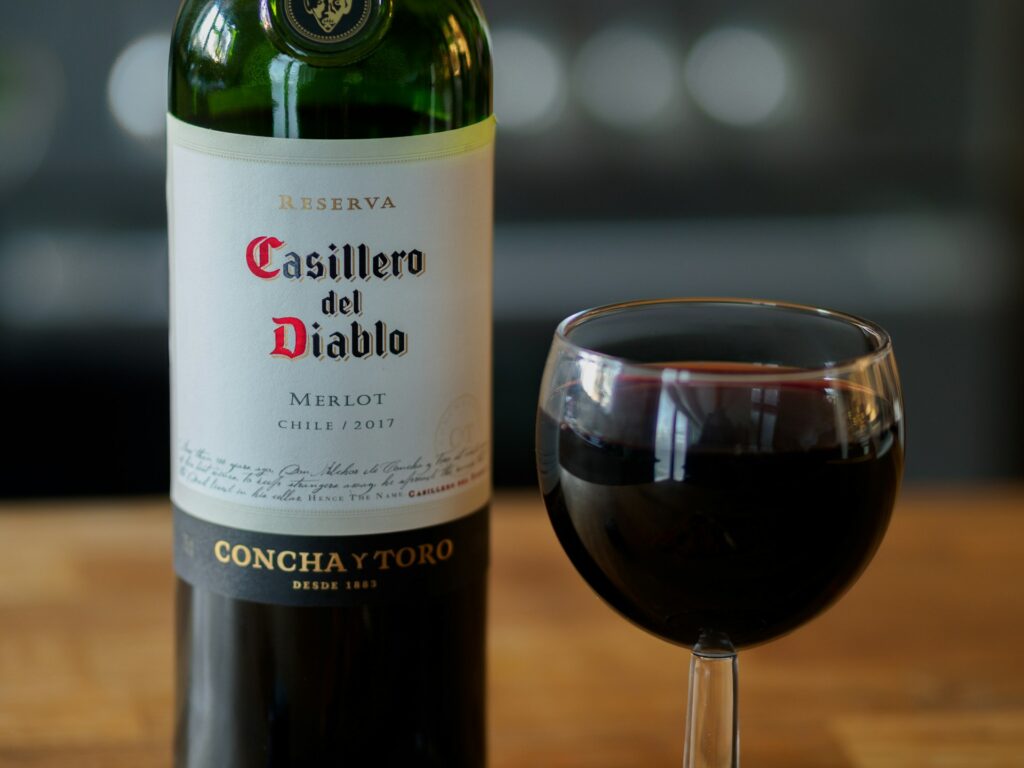Table of Contents
Have you ever been to a dinner party and heard someone say, “I’ll have a glass of Merlot, please”? It’s a popular choice, but have you ever wondered if it’s a dry wine? Well, you’re not alone. Many wine enthusiasts ponder over the dryness of Merlot. To set the record straight, yes, Merlot typically falls into the dry wine category, meaning it doesn’t have much residual sugar. But what makes it stand out?
Merlot’s flavor profile is like a gentle handshake—it’s welcoming and soft, yet leaves an impression. It’s a wine that can complement many dishes without overpowering them. Think of Merlot as a friend who gets along with everyone at the table, making it a go-to for many wine enthusiasts.
The Characteristics of Merlot
This red wine is beloved for its soft tannin levels, contributing to its smoothness. Merlot isn’t just about the taste—it’s also about the feel. Those tannins give Merlot a velvety texture that’s hard to resist, cradling your taste buds in a gentle embrace.
And let’s not forget about the alcohol levels. Merlot typically features moderate to high alcohol content, which can add to the wine’s body and warmth. This level of alcohol also helps to carry the delicate flavors and aromas, creating a harmonious balance on your palate.
Originating from the Bordeaux region of France, it has become a global favorite. Known for its plush, ripe fruit flavors and soft tannins, Merlot offers a less intimidating introduction to red wines for newcomers. It’s the kind of wine that says, “Come on in, the water’s fine!”
One thing that sets Merlot apart is its moderate to high alcohol content. This characteristic gives it a robust presence in the mouth, contributing to its full-bodied nature. It’s a wine that can hold its own, whether it’s a cozy night in or a lively dinner with friends.

Merlot’s Flavor Palette
Imagine a spectrum of lush, ripe berries meeting hints of earthy undertones—this is the essence of Merlot. But its flavor profile isn’t just a one-note song; it’s a symphony of taste that evolves with each sip. From plums to chocolate, every bottle tells its own story.
What’s remarkable about Merlot is how its flavor profile can vary depending on where it’s grown. A Merlot from California might serenade you with bold fruit flavors, while one from France might whisper of herbs and blackberries. This versatility makes Merlot a fascinating study for anyone interested in the nuances of wine.
Merlot’s Fruitiness
Merlot is like biting into a juicy plum—it’s bursting with a fruitiness that’s refreshing and satisfying. The presence of moderate to high alcohol content doesn’t just warm the throat; it also amplifies the fruity flavors, making them more pronounced and delightful on the palate.
This fruit-forward character makes Merlot an excellent partner for a variety of foods. Its ability to meld with the flavors of your meal, rather than dominate, is one of the reasons why it’s such a crowd-pleaser. So go ahead, pour a glass, and let the fruitiness of Merlot excite your taste buds.
Body and Texture: The Feel of Merlot on Your Palate
Merlot’s medium to full body means it has a substantial presence, akin to the satisfying weight of a well-woven fabric. It’s not too heavy, not too light—it’s just right.
As for the texture, Merlot is often described as smooth or even silky. This smoothness is thanks to the tannins, which are present but not overpowering, allowing for a pleasant, lingering finish. Each sip feels like a gentle caress on your palate, inviting you to savor the moment a little longer.
Tannins and Dryness: What Defines Merlot’s Dry Nature?
When wine aficionados talk about dry wines, they’re referring to the sugar content—or rather, the lack thereof. Merlot, with its low sugar content, fits snugly into the dry wine category. But it’s the tannins that seal the deal. These natural compounds, found in grape skins, stems, and seeds, contribute to the wine’s structure and mouthfeel.
Tannins also play a key role in the aging potential of Merlot. Over time, they soften, allowing the wine to develop a more complex and rounded profile. This dry nature of Merlot, paired with its tannins, provides a versatile foundation for a range of palates, making it a staple for casual drinkers and connoisseurs.
Merlot in Comparison to Other Red Wines
When you’re exploring the world of red wines, you’ll notice that Merlot has a friendliness that makes it stand out. It’s like that versatile sweater that pairs well with anything, from casual pasta dishes to a fancy dinner. For a wine enthusiast, discovering the unique characteristics of Merlot in comparison to other red wines is a delightful journey.
Merlot vs Cabernet Sauvignon
Both are stars of the red wine world, but they each bring their own flair to the table. Merlot has smooth tannins and a rounder, more plump fruit profile. Cabernet Sauvignon, on the other hand, has higher tannin levels and a more structured frame.
But what about when Merlot and Cabernet Sauvignon join forces? In Bordeaux, these two varietals often blend together, creating a wine that balances Merlot’s softness with Cabernet’s strength. It’s a match made in heaven, showcasing the best of both worlds. So, whether you’re Team Merlot or Team Cabernet, there’s no denying the unique appeal of each.
Pinot Noir and Merlot: Contrasting Sophistication
Pinot Noir and Merlot are like two artists with distinct styles. Pinot Noir, with its lighter body and higher acidity, is often seen as a drier wine compared to Merlot. It’s the kind of wine that whispers elegance and grace, with delicate on your palate. Merlot, in contrast, offers a bolder stroke on the canvas, with its richer body and plush flavors.
Despite their differences, both Pinot Noir and Merlot have a sophistication that appeals to a wide audience. Whether you prefer the gentle caress of Pinot Noir or the warm embrace of Merlot, there’s no wrong choice—only different expressions of beauty in a glass.
How to Serve: Enhancing Merlot’s Qualities
Serving Merlot at the right temperature is like hitting the sweet spot in a game of baseball—it can make all the difference. You’ll want to aim for just below room temperature to let the wine’s flavors blossom. Too warm, and the alcohol can overpower; too cold, and the subtleties might be muted. Aim for that perfect pitch to enjoy Merlot at its best.
Proper Serving Temperature for Merlot
Have you ever sipped a Merlot that didn’t quite taste right? Temperature can be the culprit. Serving Merlot too cold can mask its rich flavors, while too warm can make it seem flat. The ideal range is around 60-65°F (15-18°C)—cool enough to refresh, yet warm enough to release the bouquet of aromas and flavors. Think of it as cozying up with a soft blanket—it’s just the right amount of warmth to feel comfortable.
Getting the temperature right means you’ll experience all that Merlot has to offer. The fruit flavors will shine, the tannins will feel smooth, and the finish will linger just long enough. It’s like tuning an instrument to play the perfect note, and with Merlot, that note is rich, deep, and utterly satisfying.
Decanting Merlot: Is It Necessary?
Decanting can be to wine what a breath of fresh air is to us—it can really open it up. But is it necessary for Merlot? It depends. Younger Merlots, with their vibrant fruit and softer tannins, might not need it. But an older, more complex Merlot could benefit from decanting, allowing it to fully express its depth and nuances.
Think of decanting as letting the wine stretch its legs after a long journey in the bottle. It’s a chance for the wine to mingle with oxygen and reveal its hidden layers. So if you have the time and the inclination, give your Merlot a chance to breathe—it might just surprise you with what it has to say.
Culinary Companions: Pairing Food With Merlot
Choosing the right food to go with your Merlot is like picking the perfect accessory—it can enhance the whole experience. Merlot’s dry nature and plush fruit flavors make it a versatile companion at the table. It pairs beautifully with rich meats, hearty pasta dishes, and even some spicier cuisines, complementing and contrasting flavors in delightful ways.
Ideal Merlot Food Pairings: From Cheese to Meat
Merlot and cheese are like old friends—they get each other. A soft, creamy brie or a sharp cheddar can highlight Merlot’s fruitiness and smooth tannins. But don’t stop at cheese! Merlot’s versatility shines when paired with meats. Whether it’s a grilled steak, a juicy burger, or even a lamb chop, the wine’s flavors meld with the savory notes of the meat.
But what if you’re not a meat lover? No problem! Merlot also cozies up nicely to roasted vegetables and mushroom dishes. The key is to consider the wine’s body and flavor profile. You’ll want to match it with foods with a similar weight and richness. So go ahead, experiment, and discover your favorite Merlot pairings!
Vegetarian Dishes That Complement Merlot
If you’re diving into a glass of Merlot, have you wondered what vegetarian dish might go along for the ride? Imagine a plate of roasted root vegetables, their earthiness mingling with the berry notes of the wine. Or how about a wild mushroom risotto, where the creamy texture plays off Merlot’s velvety tannins? You see, Merlot isn’t shy about partnering with dishes that boast bold flavors.
Consider a lentil burger, seasoned with herbs that echo the herbal hints in your glass. Or a grilled eggplant with a balsamic glaze, adding a touch of sweetness that complements Merlot’s fruit-forward profile. These meat-free options don’t just pair well, they enhance the wine’s flavor, proving that you don’t need meat to make a perfect match. Have you tried any of these combinations yourself?
Merlot’s Misconceptions and Facts
Sometimes, Merlot gets a bad rap, doesn’t it? Some folks think it’s too soft, too simple. But let me tell you, Merlot is as complex as any of its red wine brethren. It’s versatile, it’s food-friendly, and it’s definitely dry. So next time you hear someone say Merlot is just a ‘beginner wine,’ you’ll know better.
The ‘Sideways’ Effect on Merlot Popularity
You remember that movie “Sideways,” right? The one where Paul Giamatti’s character rants against Merlot? Well, that scene took a toll on Merlot’s street cred. Sales dipped as moviegoers followed the lead of a fictional character, favoring Pinot Noir instead. It’s funny how a single line in a movie can sway the tastes of so many, isn’t it?
But the truth is, Merlot never lost its charm among wine lovers who know what they’re after. It’s been quietly proving its worth, glass by glass. It may not have been the star of the show for a while, but it’s been a steady presence, a reliable friend for those cozy nights in. Have you had a chance to rediscover Merlot since then?
The Alcohol Content in Merlot Bottles
Now, let’s talk about the warmth that creeps up on you as you sip your Merlot. That’s the alcohol levels at play. Typically, Merlot hovers around 13-15% alcohol by volume (ABV). It’s right there on the label, clear as day. But don’t be fooled into thinking higher alcohol means a better wine—it’s all about balance.
What’s interesting is that the alcohol content can give you a hint about the wine’s body. A Merlot with higher alcohol levels might feel fuller and richer on the palate. But remember, it’s not just about the warmth; it’s about the flavors. Does alcohol content affect your perception of a wine?

Merlot: Beyond Dryness and Sweetness
Merlot’s not just a one-trick pony, you know. It’s not just about dryness or sweetness; it’s about the layers of flavors and aromas. It’s about the way it evolves in the glass and bottle. There’s a whole world in each pour, don’t you think?
The Influence of Aging on Merlot’s Dryness
As Merlot ages, it can develop new flavors and become even smoother. You might find that a bottle with a few years on it has mellowed out, with the tannins feeling less assertive. But don’t get it twisted—aging doesn’t necessarily make the wine sweeter. Dryness is a lack of residual sugar, and aging doesn’t change that.
What aging can do is round out the wine’s edges, making it feel more cohesive on your palate. The fruit flavors might take a back seat to secondary notes of leather or tobacco. Have you had the pleasure of tasting an older Merlot?
Residual Sugar and Its Impact on Merlot’s Taste
Let’s clear something up: residual sugar is what’s left after fermentation when not all the grape sugar is converted into alcohol. But here’s the kicker—Merlot is a dry wine, meaning there’s hardly any residual sugar left. That’s right, despite its ripe fruit flavors, Merlot keeps it pretty lean on the sweetness scale.
Now, if you’ve got a sweet tooth, you might lean towards dessert wines intentionally left with more residual sugar. But when it comes to Merlot, the sweetness you’re tasting is from the fruitiness of the wine, not sugar. Isn’t it fascinating how our taste buds can be tricked into perceiving sweetness where there’s none?
Wrapping Up the Merlot Mystery
In the vast world of wine, where flavors range from the sweetest dessert wines to the most robust dry reds, Merlot holds its ground as a versatile favorite. But what’s the verdict on its dryness? Well, if you’ve ever savored a bottle of Merlot, you’ve experienced its rich, fruity notes and smooth finish. Unlike a sweet wine, which leaves a sugary residue on the tongue, Merlot is a dry red wine, characterized by its absence of that sugar-coated feeling post-sip.
Originating in France, Merlot has spread its roots to become one of the most popular wines in the world. Its balance of flavors and moderate levels of acidity contribute to its dry nature, offering a taste that’s both accessible and sophisticated. So next time you’re contemplating the options at your local wine shop, remember that a Merlot is a delightful choice for those who enjoy the complexities of a dry wine.

Sed non elit aliquam, tempor nisl vitae, euismod quam. Nulla et lacus lectus. Nunc sed tincidunt arcu. Nam maximus luctus nunc, in ullamcorper turpis luctus ac. Morbi a leo ut metus mollis facilisis. Integer feugiat dictum dolor id egestas. Interdum et malesuada fames ac ante ipsum primis in faucibus.




